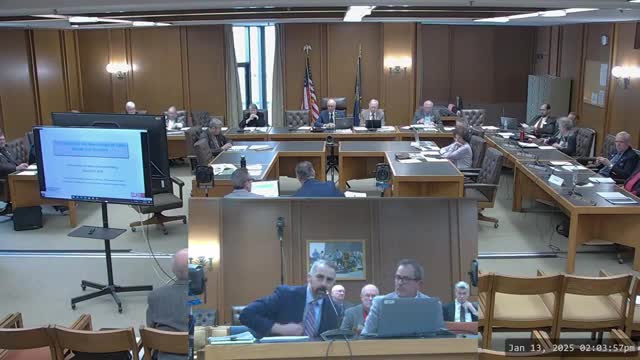Employment Security: labor markets tight, unemployment claims low but duration rising; nurse shortages highlighted
January 13, 2025 | Ways and Means, House of Representatives, Committees , Legislative, New Hampshire
This article was created by AI summarizing key points discussed. AI makes mistakes, so for full details and context, please refer to the video of the full meeting. Please report any errors so we can fix them. Report an error »

Lede: Richard (Rich) Labors, deputy commissioner at the Department of Employment Security (DES), and Brian Gottlob, director of the Economic and Labor Market Information Bureau, briefed Ways and Means on labor market conditions: private‑sector employment growth is positive, new unemployment claims remain well below pre‑pandemic peaks, but the state faces tightness in the labor supply and sectoral shortages.
Nut graf: DES presented data showing historically low new weekly unemployment claims, an employment‑to‑population ratio that indicates tight labor markets, and the continuing prominence of registered nurse vacancies and health care staffing demand. DES also described a gradual increase in average claim duration (from about 9.4 weeks at the start of 2023 to just under 12 weeks by November 2024) that affects unemployment trust fund outlays.
Body: The department showed job posting and hiring patterns: professional, scientific and technical services recorded strong private job gains (roughly a 24% increase since the pre‑pandemic peak in the sector); registered nurses were the single most‑advertised occupation and health care employers, including staffing agencies, accounted for a high share of postings. DES noted the growth of new business formations in New Hampshire — entrepreneurial filings that suggest future hiring — has outpaced the national average since 2020.
DES data also show New Hampshire’s employment‑to‑population ratio for prime‑age adults (25–54) remains above a typical “full employment” benchmark (about 85%), indicating a tight labor market. The department cautioned that labor supply constraints — demographic trends and lower labor force participation among some cohorts — are a limiting factor for recruiting employers.
DES reported weekly initial unemployment claims remain small compared to pandemic levels and that the state’s unemployment trust fund remains at a historically high level (subject of the Treasurer’s briefing). However, the average duration of claims has risen and year‑to‑date benefit outlays are approaching annualized tax receipts, which warrants monitoring.
Ending: DES offered to provide further breakdowns requested by members (for example, county‑level childcare capacity and workforce participation by cohort) and said it will return with additional analysis to support revenue estimate deliberations.
Nut graf: DES presented data showing historically low new weekly unemployment claims, an employment‑to‑population ratio that indicates tight labor markets, and the continuing prominence of registered nurse vacancies and health care staffing demand. DES also described a gradual increase in average claim duration (from about 9.4 weeks at the start of 2023 to just under 12 weeks by November 2024) that affects unemployment trust fund outlays.
Body: The department showed job posting and hiring patterns: professional, scientific and technical services recorded strong private job gains (roughly a 24% increase since the pre‑pandemic peak in the sector); registered nurses were the single most‑advertised occupation and health care employers, including staffing agencies, accounted for a high share of postings. DES noted the growth of new business formations in New Hampshire — entrepreneurial filings that suggest future hiring — has outpaced the national average since 2020.
DES data also show New Hampshire’s employment‑to‑population ratio for prime‑age adults (25–54) remains above a typical “full employment” benchmark (about 85%), indicating a tight labor market. The department cautioned that labor supply constraints — demographic trends and lower labor force participation among some cohorts — are a limiting factor for recruiting employers.
DES reported weekly initial unemployment claims remain small compared to pandemic levels and that the state’s unemployment trust fund remains at a historically high level (subject of the Treasurer’s briefing). However, the average duration of claims has risen and year‑to‑date benefit outlays are approaching annualized tax receipts, which warrants monitoring.
Ending: DES offered to provide further breakdowns requested by members (for example, county‑level childcare capacity and workforce participation by cohort) and said it will return with additional analysis to support revenue estimate deliberations.
View full meeting
This article is based on a recent meeting—watch the full video and explore the complete transcript for deeper insights into the discussion.
View full meeting
